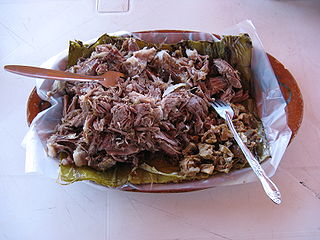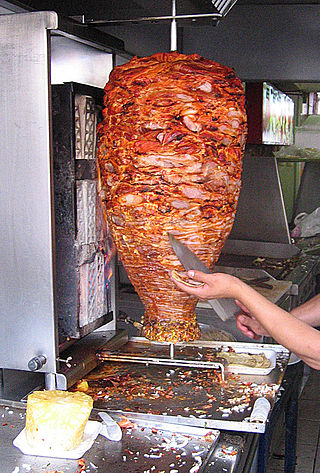
Chorizo is a type of pork sausage originating from the Iberian Peninsula. It is made in many national and regional varieties in several countries on different continents. Some of these varieties are quite different from each other, occasionally leading to confusion or disagreements over the names and identities of the products in question.

Offal, also called variety meats, pluck or organ meats, is the internal organs of a butchered animal. The word does not refer to a particular list of edible organs, and these lists of organs vary with culture and region, but usually exclude skeletal muscle. Offal may also refer to the by-products of milled grains, such as corn or wheat.

Pozole is a traditional soup or stew from Mexican cuisine. It is made from hominy with meat, and can be seasoned and garnished with shredded lettuce or cabbage, chili peppers, onion, garlic, radishes, avocado, salsa or limes. Known in Mesoamerica since the pre-Columbian era, the stew is common across Mexico and neighboring countries, served both as a day-to-day meal and as a festive dish.

Chicharrón is a dish generally consisting of fried pork belly or fried pork rinds. Chicharrón may also be made from chicken, mutton, or beef.

Barbacoa or Asado en Barbacoa in Mexico, refers to the local indigenous variation of the method of cooking in a pit or earth oven. It generally refers to slow-cooking meats or whole sheep, whole cows, whole beef heads, or whole goats in a hole dug in the ground, and covered with agave (maguey) leaves, although the interpretation is loose, and in the present day may refer to meat steamed until tender. This meat is known for its high fat content and strong flavor, often accompanied with onions and cilantro. Because this method of cooking was used throughout different regions by different ethnic groups or tribes in Mexico, each had their own name for it; for the Nahuatl it was called nakakoyonki; for the Mayan it was called píib; for the Otomi it was called thumngö.

The chile relleno is a dish in Mexican cuisine that originated in the city of Puebla. In 1858, it was described as a "green chile pepper stuffed with minced meat and coated with eggs".

Bistek, also known as bistek tagalog or karne frita, is a Filipino dish consisting of thinly-sliced beefsteak braised in soy sauce, calamansi juice, garlic, ground black pepper, and onions cut into rings. It is a common staple in the Tagalog and Western Visayan regions of the Philippines. It is eaten over white rice.

Al pastor, tacos al pastor, or tacos de trompo is a preparation of spit-grilled slices of pork originating in the Central Mexican region of Puebla and Mexico City, where they remain most prominent; today, though, it is a common menu item found in taquerías throughout Mexico. The method of preparing and cooking al pastor is based on the lamb shawarma brought by Lebanese immigrants to the region. Al pastor features a flavor palate that uses traditional Mexican adobada (marinade). It is a popular street food that has spread to the United States. In some places of northern Mexico and coastal Mexico, such as in Baja California, taco al pastor is known as taco de trompo or taco de adobada.

Carnitas, literally meaning "little meats", in Mexican cuisine, is a dish made by braising, simmering and frying pork in its own fat, lard or cooking oil. The name “Carnitas” is, historically, the colloquial name given in Mexico for the French dish Rillons de Tours also known in Spanish as Chicharrón de Tours.

Tlayuda, sometimes spelled clayuda, is a handmade dish in traditional Oaxacan cuisine, consisting of a large, thin, crunchy, partially fried or toasted tortilla covered with a spread of refried beans, asiento, lettuce or cabbage, avocado, meat, Oaxaca cheese, and salsa.

Picadillo is a traditional dish in many Latin American countries including Mexico and Cuba, as well as the Philippines. It is made with ground meat, tomatoes, and also raisins, olives, and other ingredients that vary by region. The name comes from the Spanish word picar, meaning "to mince".

Adobada is a preparation for many dishes that are common in Mexican cuisine. Adobada is generally pork marinated in a "red" chili sauce with vinegar and oregano, but it can refer to different types of meat and to marinades closer to al pastor. It is generally served on small, pliable maize tortilla along with sautéed vegetables and cheese.
Chilorio is a pork dish from the Mexican state of Sinaloa. Chilorio is generally made from pork fried in chili sauce.

Mexican street food, called antojitos, is prepared by street vendors and at small traditional markets in Mexico. Street foods include tacos, tamales, gorditas, quesadillas, empalmes, tostadas, chalupa, elote, tlayudas, cemita, pambazo, empanada, nachos, chilaquiles, fajitas, tortas, even hamburgers and hot dogs, as well as fresh fruits, vegetables, beverages and soups such as menudo, pozole and pancita. Most are available in the morning and the evening, as mid-afternoon is the time for the main formal meal of the day. Mexico has one of the most extensive street food cultures in Latin America, and Forbes named Mexico City as one of the foremost cities in the world in which to eat on the street.

Cuerito is pig skin from Mexican cuisine, Venezuelan cuisine and Spanish cuisine. Cuero is the Spanish-language word for skin, leather or hide, so cueritos means "little skins". They are usually pickled in vinegar and can be made with a spicy sauce. The vinegar can be seasoned with pineapple, dulce macho (piloncillo), cloves, peppercorns, chile de árbol and oregano. There are also family recipes.

Pork rind is the culinary term for the skin of a pig. It can be used in many different ways.

A stew is a combination of solid food ingredients that have been cooked in liquid and served in the resultant gravy. Ingredients can include any combination of vegetables and may include meat, especially tougher meats suitable for slow-cooking, such as beef, pork, venison, rabbit, lamb, poultry, sausages, and seafood. While water can be used as the stew-cooking liquid, stock is also common. A small amount of red wine or other alcohol is sometimes added for flavour. Seasonings and flavourings may also be added. Stews are typically cooked at a relatively low temperature, allowing flavours to mingle.

Lucban longganisa is a Filipino pork sausage originating from Lucban, Quezon. It is a type of de recadolongganisa. It is characterized by its use of oregano and its garlicky and sour taste. It is made with coarse and lean pork, pork fat, coarse salt, onions, garlic, oregano, paprika, peppercorns, sugar, and vinegar. It can be prepared with or without the sausage casing.
















